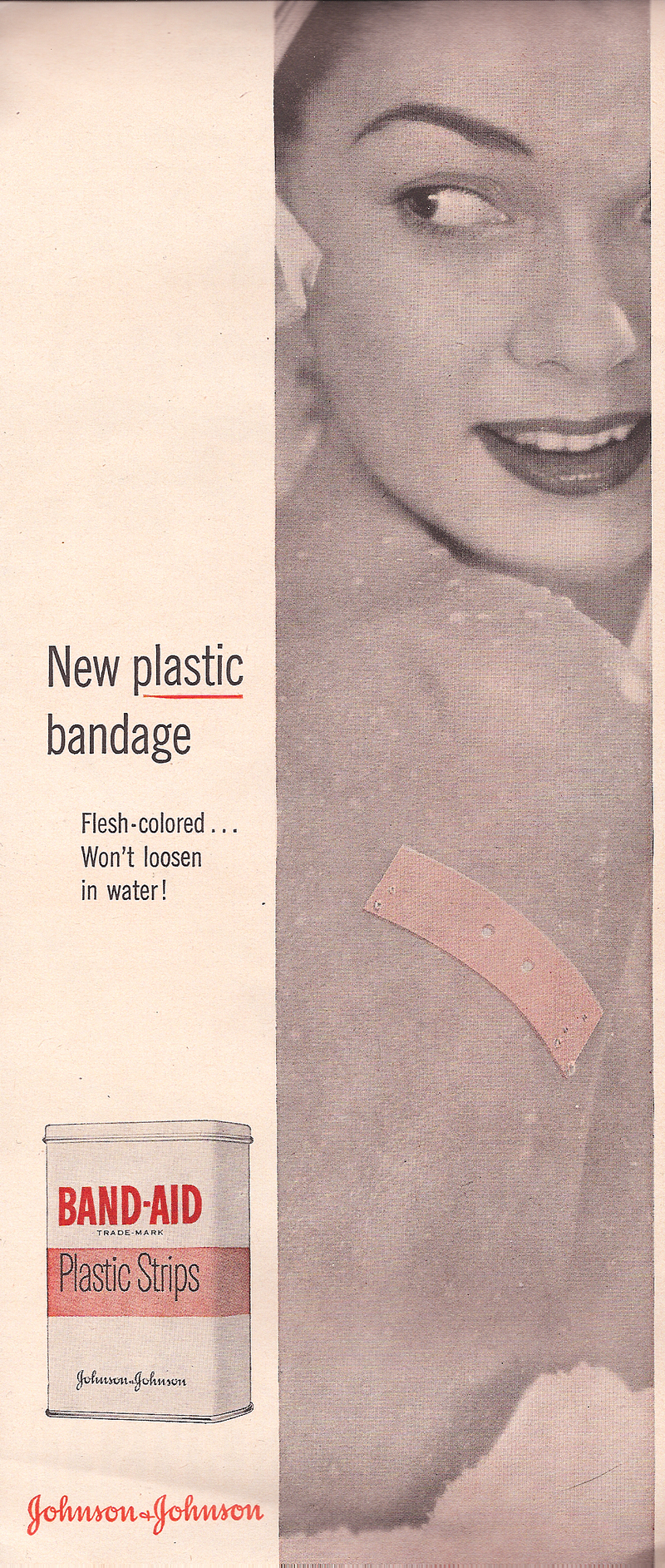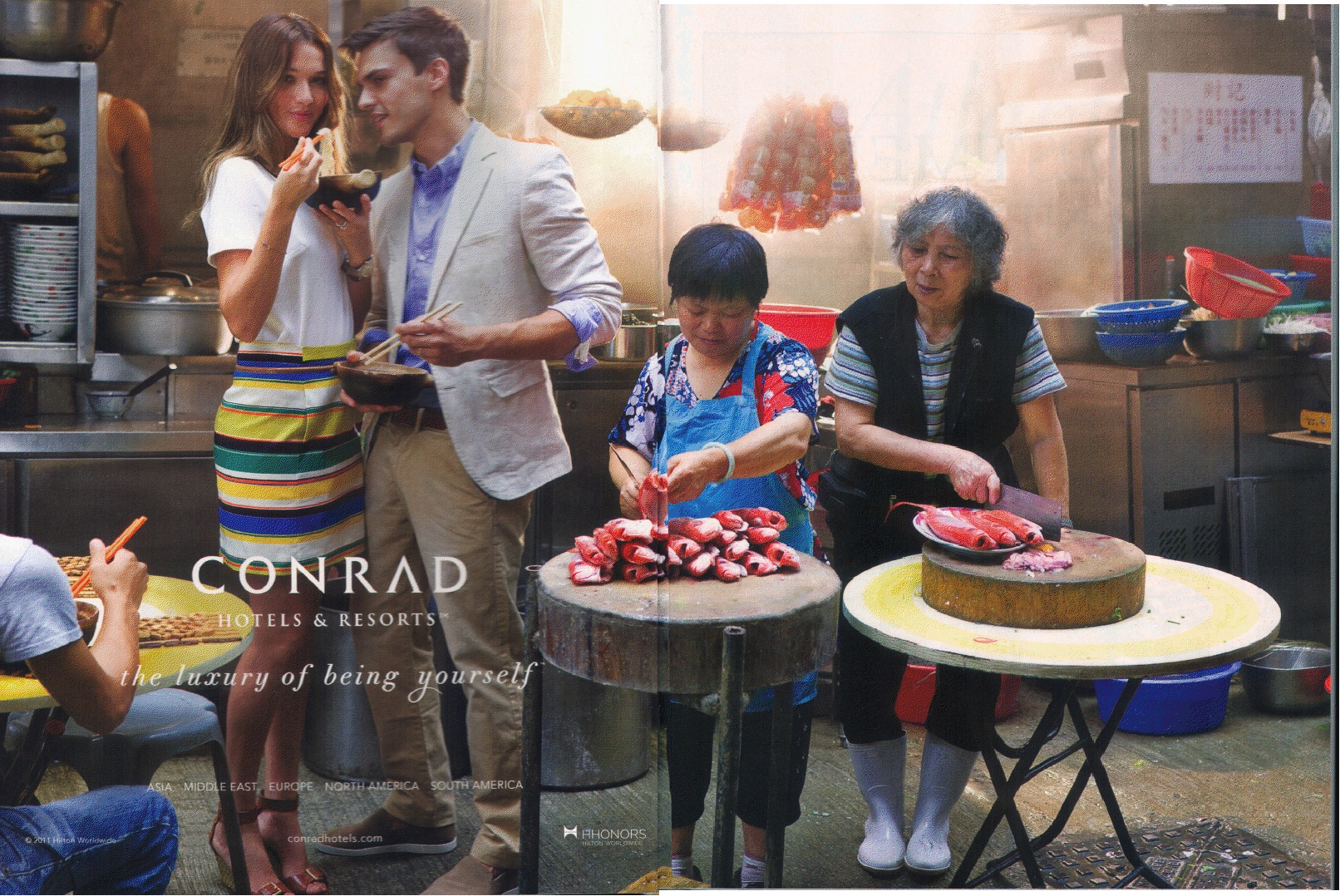 |
| A vintage ad for weight... gain? On the surface it appears that body image standards have changed, but it seems women have always been under scrutiny. Also, notice the "weight gain" accumulated in certain acceptably curvy and often sexualized areas! |
As a commercial marketing tool, advertising seeks to sell and promote to consumers through persuasion and branding. However, “advertising sells much more than products; it sells values and cultural representations, such as success and sexuality as we have seen” (Cortese 45). Advertisements reflect the dominant cultural norms. As Cortese describes in “Constructed Bodies, Deconstructing Ads: Sexism in Advertising,” “advertising reflects the traditional beliefs, myths, tales, and practices of our society and a culture based on commodities. Advertising articulates and channels cultural acts, but it does not create artificial desires nor mandate behavioral patterns” (76). Thus, while advertising does not directly cause every day violence, it contributes to prevalent attitudes that in conjunction with a lack of media literacy and unchecked regulation of images and messages can mislead easily impressionable (and already formed) minds.
Not
all advertisements are created equal: some take a more traditional,
innocuous approach, others utilize shock value. The latter is done to
receive attention, even if it trivializes serious issues and triggers
its audience. Fashion editorials, which advertise trends, brands, and
a certain lifestyle, have a history of trivializing
and glamorizing domestic violence (trigger warning). Likewise,
fashion spreads and other print advertisements use non-Western
locales and (usually non-white) people as background props, as seen
in the ad for Conrad hotels and resorts (below). The ad's tagline
reads: “the luxury of being yourself” and implicitly refers to
the young, thin, white, presumably affluent heterosexual couple in
the foreground. Coincidentally, these aforementioned descriptors of
identity fit the targeted audience of the ad as well. The Asian women
in the background sorting through fish are the “other” in the
image.
Another
vivid example of this fetishistic Orientalism is from the “Young
Turks” fashion editorial in V Magazine (issue 79, Fall 2012),
photographed by Mario Sorrenti (below):
There
are incredible sexist double standards represented in advertising.
Cortese quotes: “Ads use visual images of men and women to grab our
attention and persuade. They are really projecting gender display—the
ways in which we
think
men and women behave—not the way they actually do behave (Goffman
1976)” (52). Hence, people pick up on these social cues and often
reinforce them either through appearance, action, speech, and so on.
One does not have to search very far to find advertising images that
perpetuate normative behaviors about men and women. “Alternative”
clothing store American Apparel, whose
founder and CEO Dov Charney, a devout misogynist, actively
objectifies its female employees, both in ads and a retail setting. A
side by side comparison of women's and men's clothing ads, as they
appear on the website, demonstrate
a stark difference in gender display (below). The female models
are posed to be sexy in the eyes of the male gaze, while the male
models pose to show the function of the clothing. It is almost as
baffling as ads for clothing with naked models, like clothing
retailer Abercrombie & Fitch uses, whose CEO,
Mike Jeffries, is also an outspoken believer in upholding culturally
dominant and elitist ideas, specifically about beauty. A quick
Google images search reveals this trend of shirtless male models. The
objective is, of course, to promote an ideal, unrealistic image:
“What kind of a representations does advertising produce? It
creates a mythical, WASP-oriented world in which no one is ever ugly,
overweight, poor, toiling, or physically or mentally disabled (unless
you count the housewives who talk to little men in toilet bowls)
(Kilbourne 1989)” (Cortese 52; Kilbourne 122).
 |
| American Apparel's use of gender display and objectification of women |
It
is convenient for advertisers to target certain demographics. These
demographics are often limited in representation—they represent the
privileged and ignore the marginalized. The invisibility, erasure,
tokenization, stereotyping, and misrepresentation of marginalized
groups in advertisements and exclusion from target demographics
affect these groups adversely. Danae Clark theorizes “gay window
advertising:” “but
'gayness' remains in the eye of the beholder: gays and lesbians can
read into an ad certain subtextual elements that correspond to
experiences with or representations of gay/lesbian subculture. If
heterosexual consumers do not notice these subtexts or subcultural
codes, then advertisers are able to reach the homosexual market
without ever revealing their aim...” (144). One can look for signs
of belonging if the signs are not explicit, even if they are
unintended by the advertisers, as presented by Calvin Klein marketing
directors' rejection of the idea of appealing to gay men in their ads
(Clark 144). Clark also argues that sexual ambiguity and androgyny
(almost always leaning on the thin, white, pale, and masculine side)
became commodified as a fashion trend without their strong ties to
identity politics. Lesbian identity, as perceived by advertisers, is
thus predicated upon an alternative, not mainstream, subversive
existence.
Often
advertisements assume a default (read: usually white, sometimes male)
consumer. The term “flesh-colored,” for instance, is ubiquitously
used to describe a peachy, light skin color that is by no means the
universal “flesh” color. A vintage Band-Aid ad illustrates this
phenomenon (below). Similarly, Nivea's
“look like you give a damn” campaign blunder asserted that
black men with natural hair were uncivilized. The image of a black
man with a short haircut and little facial hair flinging a
decapitated head of a black man with an afro and facial hair with the
text “re-civilize yourself” justly created controversy. Its
racist overtones promote a very specific ideal of what “civilized”
(a very misused word) looks like.
 | |
| Band-Aid's "flesh-colored" plastic bandages |
In
order to properly read and understand advertisements, one must be
media literate. Douglas
Kellner advocates “... the need to expand literacy and cognitive
competencies in order to survive the onslaught of media images,
messages, and spectacles which are inundating our culture” (126). I
think that a critique of consumerism cannot exist without a critique
of capitalism. It is important to voice outrage at degrading and
offensive advertising images. Dismemberment in advertisements
distresses me greatly. The perpetuation of hierarchical power
structures does as well. However, as Kimberlé Crenshaw concisely
states, “tokenistic, objectifying, voyeuristic inclusion is at
least as disempowering as complete exclusion” (1261). Boycotts
can be effective too, if not on a mass scale, for it is difficult to
compete with large retailers (most people do not hand make their
products or can afford to shop more ethically), then on a personal
level. I try not to purchase from various places because of their
labor practices, marketing strategies, and prices. It is a long list
(Lush Cosmetics, Urban Outfitters, American Apparel, Forever 21,
Starbucks, etc.) It helps that I am extremely picky and have shopping
anxiety anyway, but I digress. Alternatives to mainstream advertising
images that I enjoy usually fall in the category of comedy. I believe
in using comedy as catharsis, especially to criticize existing power
structures, or in this case, representations of culture. A good sense
of humor is an asset to media literacy. Cortese writes and quotes:
“Advertisers
are constantly bombarding consumers, especially women, with the
message that they are inherently flawed—that what they are or what
they have is not enough, too much, or not good enough, (Kilbourne
1989)... There is an assumption, often explicit, that there is
something wrong with their physical appearance, dress, or body odor.
'Where did such widespread afflictions as body odor, halitosis, iron
poor blood, gray hair, water spots, vaginal odor, dish pan hands,
various small glands and muscles, and split ends come from?'
(Twitchell 1995, 32)” (Cortese 63)
A
relevant sketch from That
Mitchell and Webb Look
is below. It
satirizes
the difference between commercials for women and men.
Yet
another sketch from a British comedy series, A
Bit of Fry and Laurie,
parodies the typically faux-sensual nature of perfume commercials
(below):
Works
Cited
Clark,
Danae. “Commodity Lesbianism.” 142-151. Print.
Cortese,
Anthony. "Constructed Bodies, Deconstructing Ads: Sexism in
Advertising." Provocateur: Images of Women and Minorities in
Advertising. N.p.: Rowman & Littlefield, 1999. 45-76.
Print.
Crenshaw,
Kimberlé.
"Mapping the Margins: Intersectionality, Identity Politics, and
Violence Against Women of Color." Stanford Law Review
43.6 (1991): 1241-99. Print.
Kellner,
Douglas. "Reading Images Critically: Toward a Postmodern
Pedagogy." 126-32. Print.
Kilbourne,
Jean. Beauty and the Beast of Advertising. 121-125. Print.


No comments:
Post a Comment